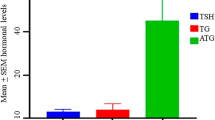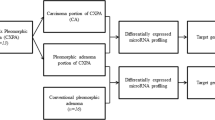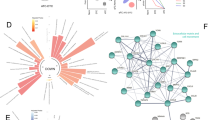Abstract
Thyroid carcinomas comprise a broad spectrum of tumors with different clinical behaviors. On the one side, there are occult papillary carcinomas (PTC), slow growing and clinically silent, and on the other side, rapidly growing anaplastic carcinomas (ATC), which are among the most lethal human neoplasms. We have analysed the microRNA (miR) profile of ATC in comparison to the normal thyroid using a microarray (miRNACHIP microarray). By this approach, we found an aberrant miR expression profile that clearly differentiates ATC from normal thyroid tissues and from PTC analysed in previous studies. In particular, a significant decrease in miR-30d, miR-125b, miR-26a and miR-30a-5p was detected in ATC in comparison to normal thyroid tissue. These results were further confirmed by northern blots, quantitative reverse transcription–PCR analyses and in situ hybridization. The overexpression of these four miRs in two human ATC-derived cell lines suggests a critical role of miR-125b and miR-26a downregulation in thyroid carcinogenesis, since a cell growth inhibition was achieved. Conversely, no effect on cell growth was observed after the overexpression of miR-30d and miR-30a-5p in the same cells. In conclusion, these data indicate a miR signature associated with ATC and suggest the miR deregulation as an important event in thyroid cell transformation.
This is a preview of subscription content, access via your institution
Access options
Subscribe to this journal
Receive 50 print issues and online access
$259.00 per year
only $5.18 per issue
Buy this article
- Purchase on Springer Link
- Instant access to full article PDF
Prices may be subject to local taxes which are calculated during checkout



Similar content being viewed by others
References
Bartel DP . (2004). MicroRNAs: genomics, biogenesis, mechanism, and function. Cell 116: 281–297.
Berlingieri MT, Pierantoni GM, Giancotti V, Santoro M, Fusco A . (2002). Thyroid cell transformation requires the expression of the HMGA1 proteins. Oncogene 21: 2971–2980.
Califano D, Monaco C, Santelli G, Giuliano A, Veronese ML, Berlingieri MT et al. (1998). Thymosin beta-10 gene overexpression correlated with the highly malignant neoplastic phenotype of transformed thyroid cells in vivo and in vitro. Cancer Res 58: 823–828.
Calin GA, Dumitru CD, Shimizu M, Bichi R, Zupo S, Noch E et al. (2002). Frequent deletions and down-regulation of micro-RNA genes miR15 and miR16 at 13q14 in chronic lymphocytic leukemia. Proc Natl Acad Sci USA 99: 15524–15529.
Calin GA, Ferracin M, Cimmino A, Di Leva G, Shimizu M, Wojcik SE et al. (2005). A MicroRNA signature associated with prognosis and progression in chronic lymphocytic leukemia. N Engl J Med 353: 1793–1801.
Cerutti J, Trapasso F, Battaglia C, Zhang L, Martelli ML, Visconti R et al. (1996). Block of c-myc expression by antisense oligonucleotides inhibits proliferation of human thyroid carcinoma cell lines. Clin Cancer Res 2: 119–126.
Chan JA, Krichevsky AM, Kosik KS . (2005). MicroRNA-21 is an antiapoptotic factor in human glioblastoma cells. Cancer Res 65: 6029–6033.
Chiappetta G, Bandiera A, Berlingieri MT, Visconti R, Manfioletti G, Battista S et al. (1995). The expression of the high mobility group HMGI (Y) proteins correlates with the malignant phenotype of human thyroid neoplasias. Oncogene 10: 1307–1314.
De Nigris F, Visconti R, Cerutti J, Califano D, Mineo A, Santoro M et al. (1998). Overexpression of the HIP gene coding for a heparin/heparan sulfate-binding protein in human thyroid carcinomas. Cancer Res 58: 4745–4751.
Donghi R, Longoni A, Pilotti S, Michieli P, Della Porta G, Pierotti MA . (1993). Gene p53 mutations are restricted to poorly differentiated and undifferentiated carcinomas of the thyroid gland. J Clin Invest 91: 1753–1760.
Fagin JA, Matsuo K, Karmakar A, Chen DL, Tang SH, Koeffler HP . (1993). High prevalence of mutations of p53 gene in poorly differentiated human thyroid carcinomas. J Clin Invest 91: 179–184.
Fedele M, Battista S, Manfioletti G, Croce CM, Giancotti V, Fusco A . (2001). Role of the high mobility group A proteins in human lipomas. Carcinogenesis 22: 1583–1591.
He H, Jazdzewski K, Li W, Liyanarachchi S, Nagy R, Volinia S et al. (2005). The role of microRNA genes in papillary thyroid carcinoma. Proc Natl Acad Sci USA 102: 19075–19080.
He L, Hannon GJ . (2004). MicroRNAs: small RNAs with a big role in gene regulation. Nat Rev Genet 5: 522–531.
Hunt JL, Tometsko M, LiVolsi VA, Swalsky P, Finkelstein SD, Barnes EL . (2003). Molecular evidence of anaplastic transformation in coexisting well-differentiated and anaplastic carcinomas of the thyroid. Am J Surg Pathol 27: 1559–1564.
Iorio MV, Ferracin M, Liu CG, Veronese A, Spizzo R, Sabbioni S et al. (2005). MicroRNA gene expression deregulation in human breast cancer. Cancer Res 65: 7065–7070.
Kondo T, Ezzat S, Asa SL . (2006). Pathogenetic mechanisms in thyroid follicular-cell neoplasia. Nat Rev Cancer 6: 292–306.
Ledent C, Dumont J, Vassart G, Parmentier M . (1991). Thyroid adenocarcinomas secondary to tissue-specific expression of simian virus-40 large T-antigen in transgenic mice. Endocrinology 129: 1391–1401.
Lee YS, Kim HK, Chung S, Kim KS, Dutta A . (2005). Depletion of human micro-RNA miR-125b reveals that it is critical for the proliferation of differentiated cells but not for the down-regulation of putative targets during differentiation. J Biol Chem 280: 16635–16641.
Liu CG, Calin GA, Meloon B, Gamliel N, Sevignani C, Ferracin M et al. (2004). An oligonucleotide microchip for genome-wide microRNA profiling in human and mouse tissues. Proc Natl Acad Sci USA 101: 9740–9744.
Martelli ML, Miano MG, Battaglia C, Trapasso F, Stella A, Iuliano R et al. (2000). The highly malignant phenotype of anaplastic thyroid carcinoma cell lines is recessive. Eur J Endocrinol 143: 515–521.
Metzler M, Wilda M, Busch K, Viehmann S, Borkhardt A . (2004). High expression of precursor microRNA-155/BIC RNA in children with Burkitt lymphoma. Genes Chromosome Cancer 39: 167–169.
Michael MZ, O'Connor SM, van Holst Pellekaan NG, Young GP, James RJ . (2003). Reduced accumulation of specific microRNAs in colorectal neoplasia. Mol Cancer Res 1: 882–891.
Pallante P, Berlingieri MT, Troncone G, Kruhoffer M, Orntoft TF, Viglietto G et al. (2005). UbcH10 overexpression may represent a marker of anaplastic thyroid carcinomas. Br J Cancer 93: 464–471.
Pallante P, Visone R, Ferracin M, Ferraro A, Berlingieri MT, Troncone G et al. (2006). MicroRNA deregulation in human thyroid papillary carcinomas. Endocr Relat Cancer 13: 497–508.
Ros P, Rossi DL, Acebron A, Santisteban P . (1999). Thyroid-specific gene expression in the multi-step process of thyroid carcinogenesis. Biochimie 81: 389–396.
Sempere LF, Freemantle S, Pitha-Rowe I, Moss E, Dmitrovsky E, Ambros V . (2004). Expression profiling of mammalian microRNAs uncovers a subset of brain-expressed microRNAs with possible roles in murine and human neuronal differentiation. Genome Biol 5: R13.
Takamizawa J, Konishi H, Yanagisawa K, Tomida S, Osada H, Endoh H et al. (2004). Reduced expression of the let-7 microRNAs in human lung cancers in association with shortened postoperative survival. Cancer Res 64: 3753–3756.
Tallini G, Dal Cin P . (1999). HMGI(Y) and HMGI-C dysregulation: a common occurrence in human tumors. Adv Anat Pathol 6: 237–246.
Volinia S, Calin GA, Liu CG, Ambs S, Cimmino A, Petrocca F et al. (2006). A microRNA expression signature of human solid tumors defines cancer gene targets. Proc Natl Acad Sci USA 103: 2257–2261.
Weber F, Teresi RE, Broelsch CE, Frilling A, Eng C . (2006). A limited set of human MicroRNA is deregulated in follicular thyroid carcinoma. J Clin Endocrinol Metab 91: 3584–3591.
Acknowledgements
This work was supported by grants from the Associazione Italiana per la Ricerca sul Cancro (AIRC), Progetto Strategico Oncologia, Consiglio Nazionale delle Ricerche, the Ministero dell'Università e della Ricerca Scientifica e Tecnologica (MIUR), Fondazione Cariverona (Verona), NOGEC-Naples Oncogenomic Center. We thank the Associazione Partenopea per le Ricerche Oncologiche (APRO) for its support.
Author information
Authors and Affiliations
Corresponding authors
Rights and permissions
About this article
Cite this article
Visone, R., Pallante, P., Vecchione, A. et al. Specific microRNAs are downregulated in human thyroid anaplastic carcinomas. Oncogene 26, 7590–7595 (2007). https://doi.org/10.1038/sj.onc.1210564
Received:
Revised:
Accepted:
Published:
Issue Date:
DOI: https://doi.org/10.1038/sj.onc.1210564
Keywords
This article is cited by
-
Contribution of microRNA-30d to the prevention of the thyroid cancer occurrence and progression: mechanism and implications
Apoptosis (2023)
-
Spectrum of microRNAs and their target genes in cancer: intervention in diagnosis and therapy
Molecular Biology Reports (2022)
-
Association between single-nucleotide polymorphisms in miRNA and breast cancer risk: an updated review
Biological Research (2021)
-
Lactate induces aberration in the miR-30a–DBF4 axis to promote the development of gastric cancer and weakens the sensitivity to 5-Fu
Cancer Cell International (2021)
-
Molecular Pathology of Poorly Differentiated and Anaplastic Thyroid Cancer: What Do Pathologists Need to Know?
Endocrine Pathology (2021)



